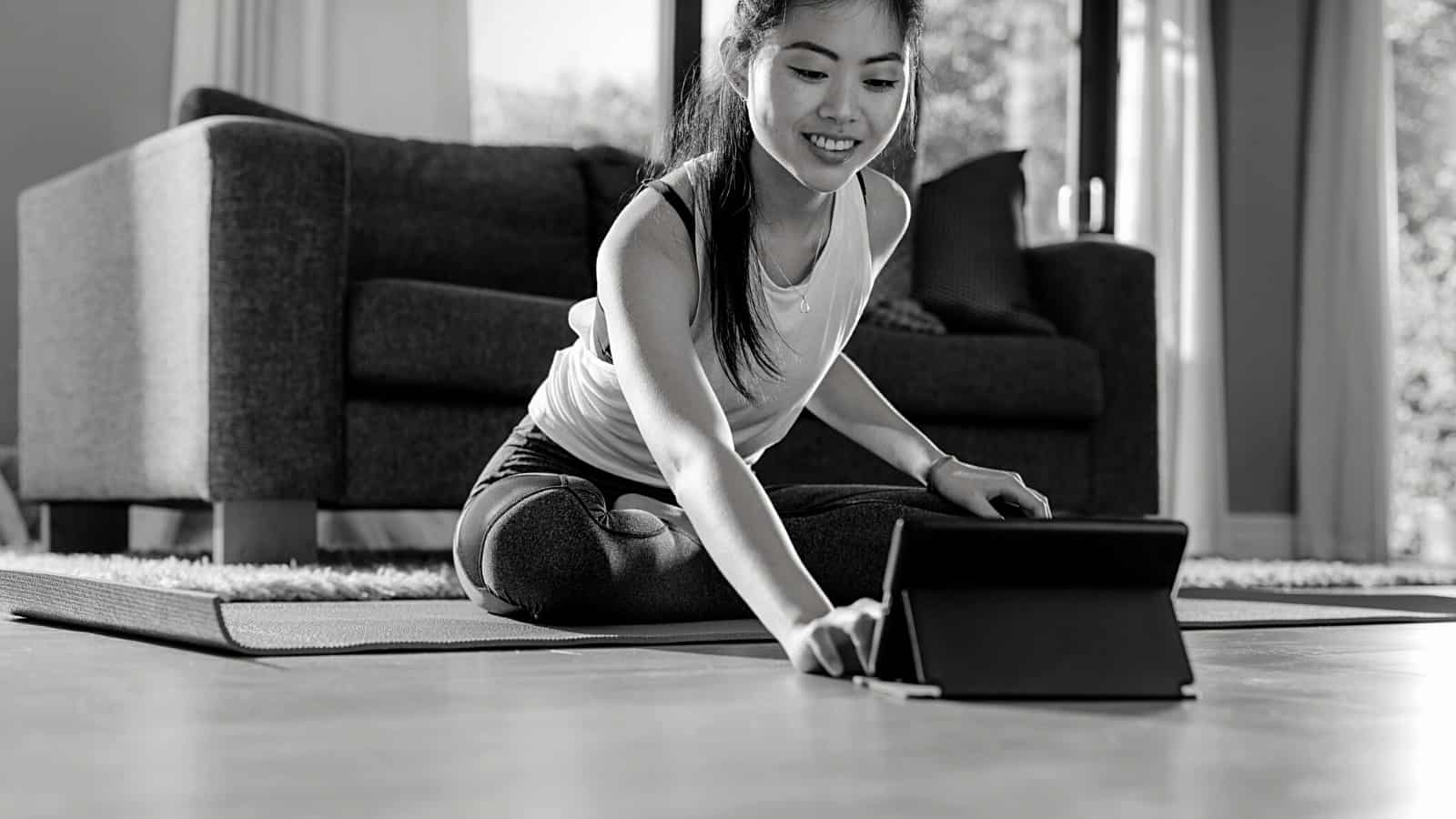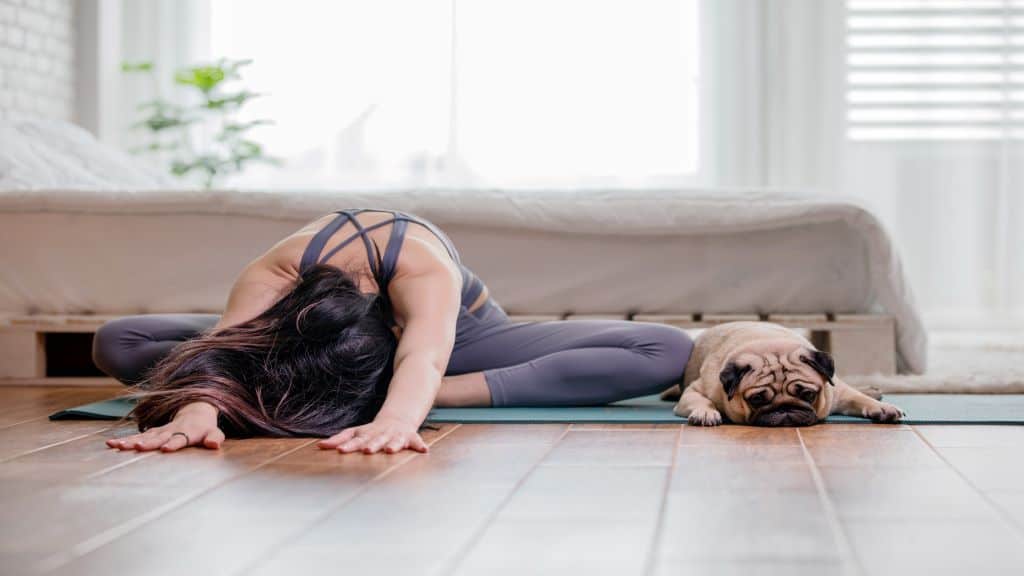When so many gyms closed around the world, people started looking for online workout routines. And that makes sense. We all know a connection exists between exercise and the immune system. So it was smart for people to get their blood pumping.
But just because we can’t work out at the gym doesn’t mean we can’t get our sweat on in more creative ways! With so many workout apps, sites, and programs online today, you have an abundance of choices when it comes to breaking a sweat. You can even pop in an old dance workout video or play on the WiiFit – the choices are endless!
Of course, with so many options, you might become overwhelmed and not even know where to start, so we’ve found five good choices for workout routines you can do at home. Here they are, in no particular order.
The Connection Between Exercise and Immune System
You knew that exercise could help you stay healthy. But you might be surprised at how closely they link to each other.
Fewer Upper Respiratory Tract Infections
Studies prove that people who regularly exercise experience fewer upper respiratory tract infections than those who don’t. Throughout a one-year observational study, researchers monitored healthy adults to reveal a decrease in the number of upper respiratory tract infections by 29%.
As you exercise, your lungs work harder to bring in oxygen and deliver it to the muscles. This increased effort increases the activity of the respiratory system entirely, which results in fewer upper respiratory tract infections.
This same study went on to show that exercising once in a while doesn’t offer this benefit. Instead, exercise regularly to experience fewer upper respiratory tract infections. For the best results, you must exercise at least five days a week for more than twenty minutes at a time.
Flushes Bacteria and Prevents Growth
Another connection between exercise and the immune system is that activity can help flush bacteria out of your lungs and airways. When the bacteria are flushed out, it reduces your risk of catching a cold, the flu, or other illness.
Since your body temperature rises during and after exercise, it also prevents bacteria from growing. If any bacteria aren’t flushed out, your body will fight them more efficiently as their growth is limited.
Decreases the Release of Stress Hormones
Stress hormones increase your risk of developing an illness. As you exercise, these stress hormones aren’t released quickly, limiting their negative effect on your immune system. Not only do high-stress levels lead to illness, but they can also cause temporary inflammation.
While temporary inflammation might not seem as bad as chronic inflammation, it can lead to illness and complications. Decreasing the release of stress hormones through exercise is a quick and effective solution.
Prevents and Decreases Chronic Inflammation
Chronic inflammation slows the circulation of immune cells in your body, making you more susceptible to illness. Not only does it slow the circulation, but it can cause drastic issues for your entire system.
When immune cells move around your body and encounter inflammation, your immune system becomes inflamed, too. An inflamed immune system increases your risk of becoming ill and struggling to fight it off.
Studies show a direct link between regular exercise and the immune system because of decreased inflammation. With regular exercise and a decrease of chronic inflammation, your body is better equipped to fight off infection.
Improves the Circulation of Immune Cells and Antibodies
As you exercise, your antibodies and white blood cells begin to circulate better. Your white blood cells are the ones that fight disease, so rapid circulation allows for quick detection of illnesses. With quick detection, your body can begin to fight off the illness before it worsens.
White blood cells and antibodies aren’t the only immune cells that will circulate better, either. Other essential immune cells such as neutrophils, monocytes, natural killer cells, and killer T cells also come into action.
These immune cells are typically in your spleen, lymph nodes, and bone marrow. However, when illness is detected, they are called into circulation.
Limits Aging of the Immune System
Like the rest of your body, your immune systems age the say way. With regular exercise, you can improve the longevity of your immune system, preventing you from becoming frail as you age.
Studies from the University of Valencia review explain that resistance, balance, endurance, and coordination training specifically help limit the aging of the immune system. This surprising connection between exercise and the immune system offers long-term benefits.
Wounds Heal Faster
Your immune system’s first line of defense is physical barriers such as the skin. Your skin keeps viruses and bacteria out of your body, but a wound removes that protection. When you have a skin puncture, germs can enter your body through the open skin, resulting in infection.
If you can heal quicker after getting hurt, there is less risk of pathogens entering the open wound. Regular exercise has proven effective for speeding up the healing process of wounds, making it a benefit to your immune system.
Helps Your Body Identify Germs Better
As your body’s third line of defense, adaptive immunity helps your body identify germs more effectively. Adaptive immunity, sometimes referred to as memory immunity, includes lymphocytes called T and B cells. When you exercise regularly, your body maintains a healthier number of T cells even as you age.
By maintaining a healthy number of these defense cells, your immune system can quickly identify pathogens and cancer cells. Plus, the germs won’t be overlooked or missed by your immune cells, either, if you exercise frequently.
Improves Vaccination Response
I know that not everyone chooses to get vaccinated, but those that opt for vaccination want a positive immune response. Studies show that exercise improves people’s vaccination responses significantly. I make sure to get familiar with the different types of vaccination. I also love to read about the production of vaccines as it is so interesting.
Vaccinations test how well the immune system works by attempting to coordinate and produce antibodies. People that regularly exercise develop more antibodies from the vaccination than those that live a sedentary lifestyle.
Helps Maintain a Healthy Sleep Routine
If you aren’t getting enough rest, your immune system won’t work as efficiently as it should. Exercise is a beneficial way to alleviate this problem, as exercise promotes healthy sleep. Regular exercise can help you fall asleep faster and get nights of more restorative sleep.
With sufficient and high-quality sleep, your innate and adaptive immunity will improve. You will also experience less severe allergic reactions if your body is well-rested.
5 Home Workout Routines You Can Do At Home to Boost Your Immune System
1 – Practice yoga.
Yoga helps strengthen the body, but it also helps calm the mind and unite your soul with a higher consciousness. So, if you’ve been feeling stressed about this whole shutdown situation, yoga can help lower your cortisol while also giving you a great workout! While some types of yoga don’t burn as many calories, you can choose others such as Vinyasa or Bikram that will really get your heart pumping.
It also involves breathwork and mindfulness to get more in tune with your body, which helps balance the chakras. Yoga does so much for the mind, body, and soul that it might just top any other type of workout you can think of doing. You can find plenty of free YouTube videos to get you started, or if you want a membership, there are sites such as yogaglo.com that provide different types of yoga and meditation for a low monthly cost.
The great thing about yoga is that anyone can do it, whether you’ve been practicing for years or have just started getting into it.
Here are just a few benefits of yoga:
- Reduces frequency and severity of migraines. A 2007 study placed 72 migraine patients into two groups: either self-care or yoga therapy. After three months, those who did yoga had the most drastic decreases in the severity of migraines.
- Improves cardiovascular health. Since yoga lowers stress, it can also help decrease blood pressure and heart rate, contributing to heart disease and strokes.
- Reduces chronic pain. Yoga helps to increase stamina and endurance, which can, in turn, boost resilience to pain.
- Improves balance and flexibility. One 2014 study split 66 elderly individuals into two groups: one that practiced calisthenics and one that did yoga. A year later, the group that did yoga had a staggering four times the flexibility of the calisthenics group.
- Helps depression and anxiety. By lowering stress and calming the mind, yoga can help ease depression and anxiety symptoms. In fact, one study found that more than half of women with PTSD who did yoga just once a week didn’t meet the criteria for PTSD any longer.
- Improves sleep quality. Lower stress, anxiety, and depression help lower cortisol, which often keeps people up at night.
- Lowers inflammation. Also, lower cortisol means that the body can function better overall, and improved circulation from yoga can decrease inflammation.
2 – Woodchoppers
If you need a good ab workout, look no further than this exercise to bolster your immune system! It targets both the abs and obliques for a full ab blaster, and the movements help strengthen the core and improve posture. This exercise can also improve balance and stability.
How to do them:
- Stand shoulder-width apart with the feet pointed slightly outward.
- Begin to squat until your thighs are parallel to the floor, but remember not to slouch your back.
- Hold a small weight with both hands and put it on the outer side of your right thigh.
- Turn your torso to the side and lift the weight up and across your body diagonally, so it’s above the left shoulder.
- Keep both arms straight as you lift your body back up. Then, stand and turn your torso, so you’re facing the dumbbell.
- Use your core muscles to control the movement as you lift your body and twist your torso. Come all the way up on your toes at the end.
- Return to the beginning position by reversing the twisting. As you bring the dumbbell back down, it will look like you’re chopping wood.
- Do three sets of 10 to 15 reps on each side.
3 – Box jumps
Box jumps fall under the classification of a plyometric workout which puts your whole body to work. While it’s a simple exercise, it’s also pretty tough and will definitely give you a good addition to your home workout routine. It engages your legs, core, and back muscles as you use your body to jump onto the box and back down again. By engaging the whole body, you’ll help improve endurance, stamina, and cardiovascular health.
How to do them:
- First, you need to get a box or find a platform or ledge to jump on.
- Stand with your feet shoulder-width apart close to the box or platform.
- Bend your body into a partial squat, pull your arms backward, and then swing them forward as you launch your body toward the box.
- Try to land as softly as you can on the box, so you don’t injure your ankles or legs.
- To come back down, you can either jump down or lift one leg at a time, which will strengthen the gluten as well.
- Try to do at least 10-15 jumps to begin with, and increase over time as you get stronger.
4 – Donkey kicks
Donkey kicks are a simple yet effective exercise that targets the glutes as well as the core. This workout also trains your lower back, pelvic floor, and shoulders. You can add donkey kicks into your normal workout routine if you want to increase your strength and reduce love handles.
How to do them:
- Get on your hands and knees and keep your face parallel to the floor.
- Keep your back straight and keep your abs tight.
- Raise your right knee and kick it out and up so that your left thigh is still parallel to the floor.
- Return to the starting position and repeat 10 times. Switch legs and do the exercise again. Try to do 3 sets on each side.
5 – Side planks
Planks help strengthen the core and target your back, shoulders, neck, and chest as well. You can do different plank variations to target different muscle groups, but the side plank specifically targets the obliques and core.
Here’s how to do it:
- Lie on your side with your legs stretched out and on top of each other. Put your right elbow directly beneath your shoulder, and keep your head aligned with your spine.
- Contract your ab muscles, inhale, and pull the navel in toward your spine.
- Exhale and lift your knees and hips off the floor, keeping your torso in a straight line. Hold this for at least 20 seconds, to begin with.
- Gradually work your way up to holding one minute on each side. Then, switch sides and repeat.
Besides Exercise, Try These Things to Increase Your Immune System
- Eat a balanced diet with plenty of fruits and veggies. Processed sugars, alcohol, caffeine, recreational drugs, white flour, fast food, and boxed foods all lower your immune system. Make sure to keep your vibration high by choosing as many raw fruits and veggies as you can. Also, eat brown rice, quinoa, nuts, seeds, unpasteurized dairy, pasture-raised eggs, and, if you choose, lean meats such as chicken and turkey. Salmon is great for Omega-3 and 6 fatty acids, but you can also take a fish oil supplement.
- Get plenty of sleep. A lack of sleep can affect your immune system over time because it increases cortisol, and therefore, inflammation. Make sure you get at least 7-8 hours of sleep per night. Turn off technology a couple of hours before bed and have a bedtime routine each night.
- Drink lots of water. Roughly 60-70% of our bodies are water, so it makes sense that we need to replenish our water as much as we can! Many people suffer from chronic dehydration, so bring a bottle with you wherever you go, and choose filtered water whenever possible.
Final Thoughts About the Link Between Exercise and Your Immune System
We have immune systems to keep our bodies healthy and away from harmful invaders such as viruses. However, if we abuse our bodies with unhealthy foods, lack quality sleep, exercise, and have a highly stressful life, our immune systems can’t do their jobs. So, the workout routines listed above will help build your immunity by increasing your strength, endurance, and stamina.
Also, eating a healthy diet, getting plenty of sunshine, having a sleep routine, drinking plenty of water, and keeping your stress low will give your immune system all it needs to do its job properly.

















 Community
Community

